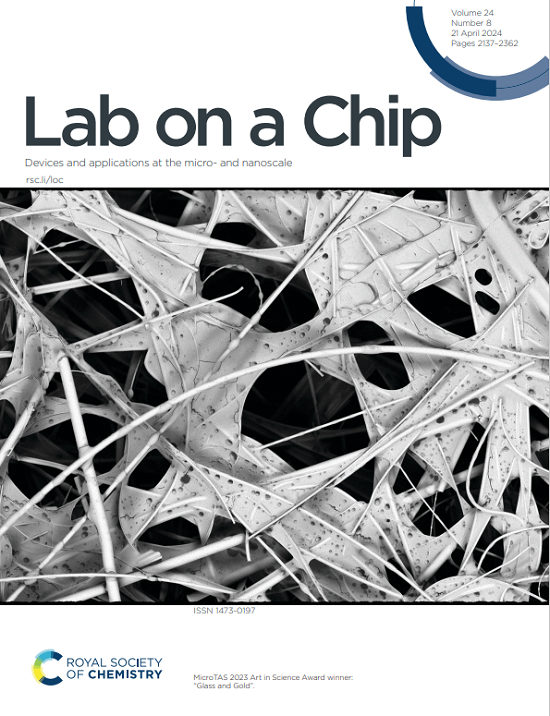Enhancing cancer therapy via acoustics: chemotherapy-enhanced tunable acoustofluidic permeabilization (ChemoTAP).
IF 5.4
2区 工程技术
Q1 BIOCHEMICAL RESEARCH METHODS
引用次数: 0
Abstract
Mechano-chemo cancer treatment is an emerging therapeutic strategy that enhances chemotherapy efficacy by combining chemical agents with mechanical forces to improve drug uptake and overcome resistance. However, current approaches for delivering mechanical forces, including magnetic stress, hydrodynamic shear, and ultrasonic cavitation, suffer from limited tunability, poor spatial precision, and off-target effects, restricting their clinical potential. Here, we introduce ChemoTAP (chemotherapy-enhanced tunable acoustofluidic permeabilization), an acoustofluidic system that utilizes standing surface acoustic waves (SAWs) to achieve highly localized, tunable mechanical stimulation, enhancing tumor cell permeability and improving chemotherapeutic efficiency. By fine-tuning SAW parameters, ChemoTAP transiently modulates membrane permeability by activating mechanosensitive ion channels, leading to cytoskeletal remodeling and a 2.73-fold increase in intracellular calcium ion flux in HeLa cells. This SAW-induced mechanotransduction response synergistically enhances the cytotoxic effects of cisplatin, increasing tumor cell apoptosis by 1.78-fold through mitochondrial membrane depolarization, reactive oxygen species generation, and endoplasmic reticulum stress pathways. Unlike conventional ultrasound-based cavitation methods, ChemoTAP enables precise, non-invasive mechanical stimulation without requiring microbubbles, offering a controllable and scalable alternative for mechano-chemo cancer treatment. ChemoTAP establishes a foundation for further studies in mechanotherapy treatment pathways and promotes the broader integration of acoustics in oncology.通过声学增强癌症治疗:化疗增强可调声流渗透(ChemoTAP)。
机械化疗癌症治疗是一种新兴的治疗策略,通过将化学药物与机械力相结合来提高化疗疗效,从而提高药物的吸收和克服耐药性。然而,目前用于传递机械力的方法,包括磁应力、流体动力剪切和超声空化,存在可调性有限、空间精度差和脱靶效应等问题,限制了它们的临床应用潜力。在这里,我们介绍ChemoTAP(化疗增强可调声流渗透),一种利用驻表面声波(saw)实现高度局部可调机械刺激的声流系统,增强肿瘤细胞的通透性,提高化疗效率。通过微调SAW参数,ChemoTAP通过激活机械敏感离子通道瞬时调节膜通透性,导致HeLa细胞的细胞骨架重塑和细胞内钙离子通量增加2.73倍。这种saw诱导的机械转导反应协同增强了顺铂的细胞毒性作用,通过线粒体膜去极化、活性氧生成和内质网应激途径使肿瘤细胞凋亡增加了1.78倍。与传统的超声空化方法不同,ChemoTAP可以实现精确、无创的机械刺激,而不需要微泡,为机械化疗癌症治疗提供了一种可控和可扩展的替代方案。ChemoTAP为机械治疗途径的进一步研究奠定了基础,并促进了声学在肿瘤学中的更广泛整合。
本文章由计算机程序翻译,如有差异,请以英文原文为准。
求助全文
约1分钟内获得全文
求助全文
来源期刊

Lab on a Chip
工程技术-化学综合
CiteScore
11.10
自引率
8.20%
发文量
434
审稿时长
2.6 months
期刊介绍:
Lab on a Chip is the premiere journal that publishes cutting-edge research in the field of miniaturization. By their very nature, microfluidic/nanofluidic/miniaturized systems are at the intersection of disciplines, spanning fundamental research to high-end application, which is reflected by the broad readership of the journal. Lab on a Chip publishes two types of papers on original research: full-length research papers and communications. Papers should demonstrate innovations, which can come from technical advancements or applications addressing pressing needs in globally important areas. The journal also publishes Comments, Reviews, and Perspectives.
 求助内容:
求助内容: 应助结果提醒方式:
应助结果提醒方式:


